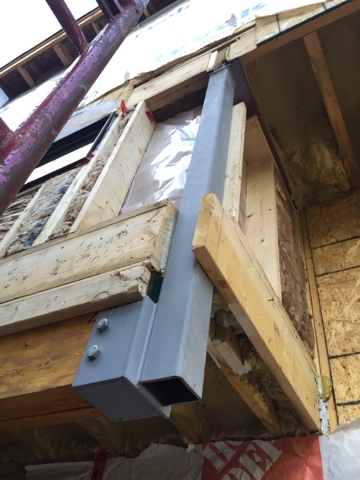When we made the plans for our "modest second story addition" it had two bedrooms, a small study area and two bathrooms upstairs. It was a simple pop-the-top and build straight up sort of idea. But there was one problem. The Japanese-style bathroom was only accessible via the master bedroom. Now, I know it's all the rage the have sprawling master bedrooms with large ensuite baths. But a Japanese bath is a family thing. You wash yourself thoroughly before getting into the tub to relax. Because the tub stays clean, the whole family can use it without having to drain and run the water between each person. Which is good because Japanese baths are usually very deep. Now, it might seem a little odd to westerners but it is really no different than using a jacuzzi. And when you have little kids they may go with mom or dad to have a bath. In Japan when you go to a hot springs resort, you have to wash yourself thoroughly with soap and hot water before you go into the hot springs. The men's and women's baths are separated, so you just go in, wash and bathe with a small towel. When you get in the hot pool you leave the towel out of the water, sometimes by folding it and putting it on your head. And when you get out you might just hold the towel in front of you for modesty. If you're modest.
Anyway, there's a whole bathing culture in Japan that's a far cry from running a hot bath and jumping in to stew in your own grease. And having the Japanese bath be accessible to the entire household was important. So this meant the design needed to be tweaked.
What we thought would involve relocating a doorway proved to be exceedingly difficult since we were working with a very small house to begin with. The architect tried dozens of ideas but eventually resolved that the program couldn't be completed without introducing an overhang, where the second story is slightly bigger than the first. So that is how the overhang came to be.
Now with the overhang, we had an odd unused space beside the stairs where they came up from the main floor to the second floor. What to do with this space? The architect decided to make it a small indoor garden. In Japan this is called a tsuboniwa, and they're common in the old merchant houses of Kyoto. So that sounded really great.
The only problem is this garden was positioned sort of halfway up between the first and second stories, on the level of the stair landing, so the floor and walls of the garden would have to be supported from below by either the carport structure or some funky internal steel structure.
When it turned out - much to my frustration - that the carport had been designed without regard for the city bylaws on setbacks, it became necessary to go the route of the internal steel structure, and hope to be granted a minor variance to build the carport later.
So we hired the engineer to redo all the floor structural design and specify the required steel. The builder then installed the steel beams, but here's the trouble: he didn't install the steel parts on the ends of those beams to support the garden. There were just these two big steel beams serving no purpose whatsoever. What the engineer specified was simply ignored.
Those red steel beams were supposed to have drop-down steel "hangers" welded onto the ends to hold up the garden. Instead the garden was built with nothing holding up the floor, wall and roof above.
When our builder walked off the job, he left us with these serious structural issues and more. The carport had to be phased out due to cost, and both the engineer and architect strongly recommended opening the walls to add the requires steel supports instead.
Now, at the end of the day I'm not convinced that opening the walls and welding in steel posts and saddles was going to be all that much cheaper than building on the carport, but everybody including the new builder said it would save a bunch, so we went with it. We can add the carport later and it'll be a "belt and suspenders" approach to the garden.
With all that backstory out of the way, the new builder was hard at it this week to complete all the structural deficiency work. Although they're awaiting some soil tests and a bit of strapping material, the end of fixing the structural issues is in sight. In the past week they completed the structural remediation for the hanging garden, a major part of the work. It was quite amazing to see this happen in the space of two or three days.
And while the exterior structural work was happening, a tiler has been busy at work on the inside, and what a difference it makes to see the tile going on. It seems that he's done a very good job particularly with the difficult areas around sills and ledges. Our new builder also went the extra mile to level the ceiling above the bath, which the old builder had done such a bad job of that it drooped down about an inch in one of the corners. When you install tiles, nice and square, with straight grout lines, and crookedness in the walls and ceiling really stand out. So the new builder, without even being asked, simply cut out the drywall and leveled the area.













No comments:
Post a Comment
Note: Only a member of this blog may post a comment.